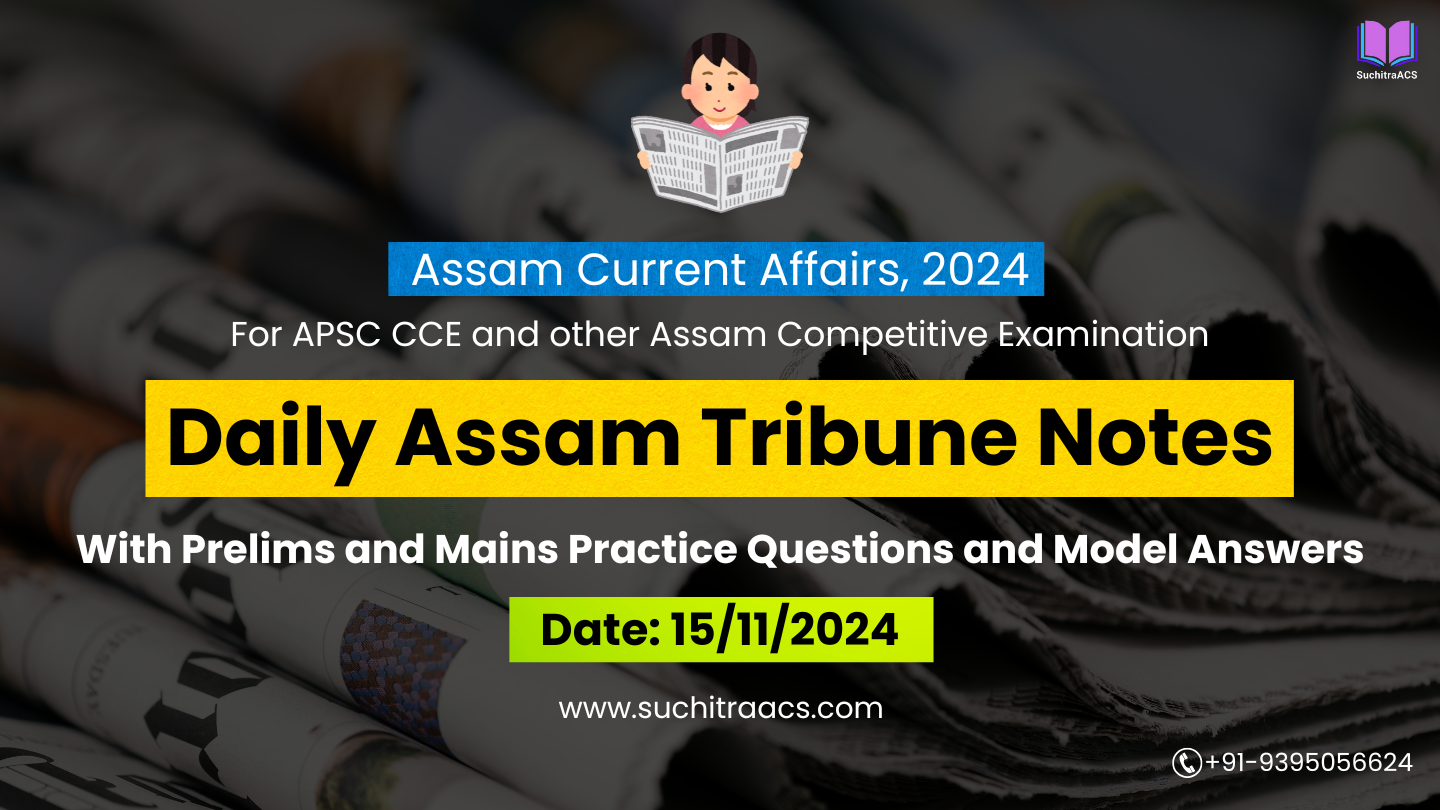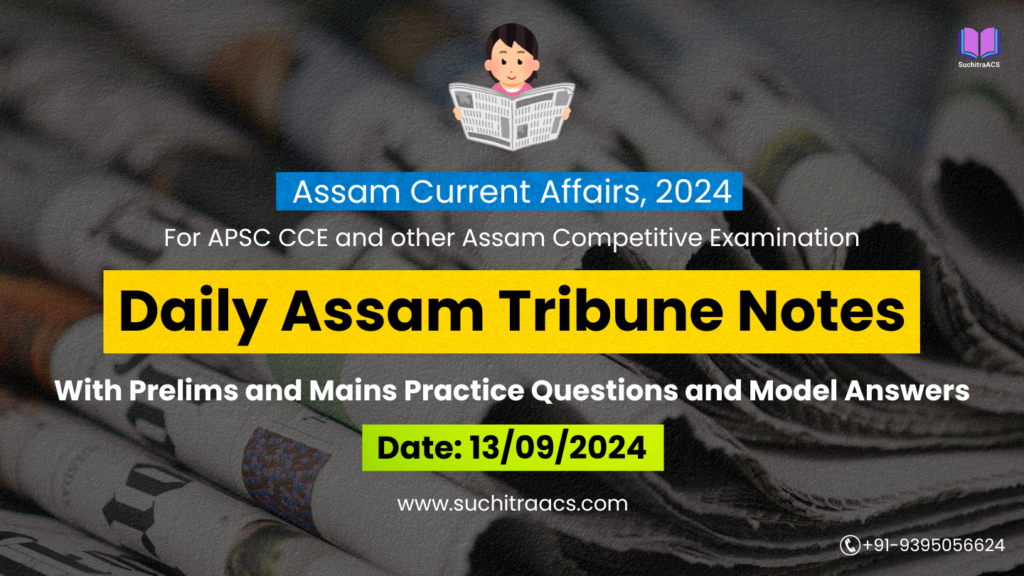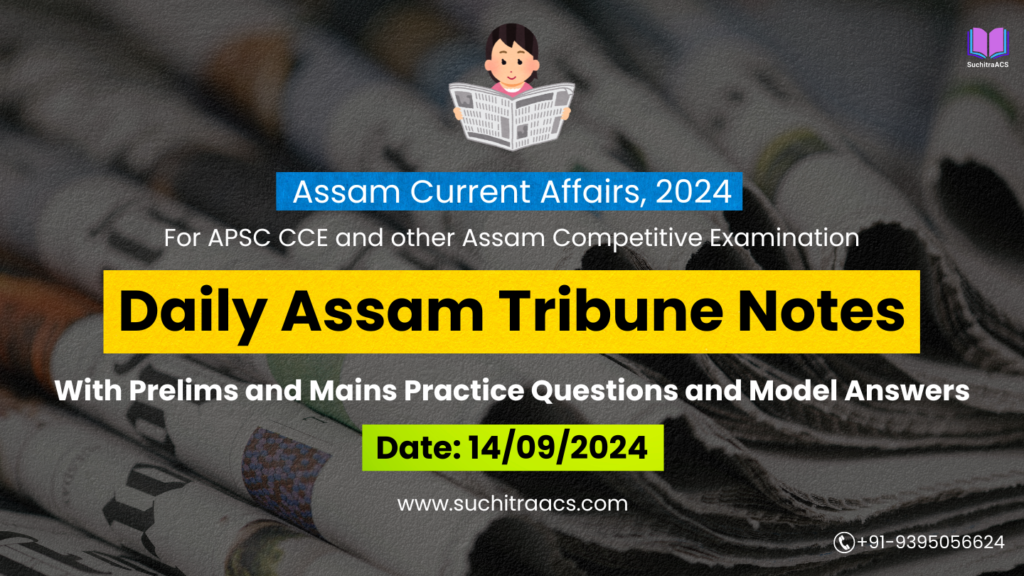APSC Current Affairs: Assam Tribune Notes with MCQs and Answer Writing (15/11/2024)
For APSC CCE and other Assam Competitive examinations aspirants, staying updated with current affairs is vital. This blog covers most important topics from the Assam Tribune today (15-11-2024). These issues are key for both APSC Prelims and Mains preparation, offering insights into the APSC CCE Syllabus.
Topic 1: Uncertainty Around Assam’s NRC Implementation
GS Paper 2: Polity and Governance
Introduction:
The Assam National Register of Citizens (NRC) was released in 2019, excluding over 1.9 million people. Since then, the implementation and recognition of NRC as an official document have been surrounded by uncertainty, with both the Central and State governments yet to clarify their stance.
Key Points:
- The NRC was meant to serve as a citizenship verification tool for Assam, focusing on individuals who could not provide adequate proof of citizenship.
- Exclusion from the NRC does not yet equate to official non-citizen status, as judicial and administrative appeals are still possible.
- Local groups and political leaders are divided over its validity, with calls for re-verification by organizations like the All Assam Students’ Union (AASU).
Prelims Pointers:
- NRC (National Register of Citizens): A document aimed at identifying citizens based on legacy data, used mainly in Assam.
- AASU: A prominent student organization in Assam advocating for the protection of indigenous rights.
- 1951 NRC and 1971 Voter List: Used as baseline data for NRC verification.
Mains Pointers:
- Importance:
- Identity Verification: Provides a systematic framework to determine legal citizenship.
- Regional Stability: Aims to mitigate ethnic tensions related to demographic changes.
- Legal Framework: Sets a precedent for citizenship verification.
- Cultural Protection: Intended to safeguard the rights of indigenous communities.
- Basis for Future Policies: Offers data for policy planning in demographically sensitive areas.
- Challenges:
- Legal Ambiguities: Unclear definitions of who is excluded from citizenship.
- Administrative Delays: Slow processing of appeals and claims.
- Public Confusion: Lack of awareness about the NRC’s implications.
- Political Polarization: Diverse stances among political parties hinder consensus.
- Resource Strain: High costs and administrative burden on local authorities.
- Way Ahead:
- Clear Government Stance: Urge clarification on the NRC’s legal status.
- Public Awareness Drives: Inform the public about NRC implications.
- Judicial Support: Expedite appeals and grievances through dedicated courts.
- Stakeholder Engagement: Involve civil society and community leaders in NRC-related discourse.
- Policy Reforms: Strengthen policies around citizenship documentation and migrant rights.
Conclusion:
Clarifying the NRC’s role in Assam is essential for maintaining social harmony and upholding the rights of citizens. Transparent and inclusive policies can support peace and stability in the region.
Topic 2: Reimposition of AFSPA in Manipur’s Volatile Regions
GS Paper 3: Internal Security
Introduction:
The Armed Forces Special Powers Act (AFSPA) has been reimposed in six areas in Manipur amid ongoing ethnic conflicts. This controversial law grants military forces significant powers in “disturbed areas” to restore peace but has faced criticism due to concerns over civil rights.
Key Points:
- AFSPA was reintroduced in response to ethnic tensions and violence between the Meitei and Kuki communities.
- The law provides broad authority to armed forces, including search, arrest, and use of force.
- Recent escalations in violence have led the Central government to declare certain areas “disturbed.”
Prelims Pointers:
- AFSPA: A law providing special powers to the armed forces in regions declared as disturbed.
- Meitei and Kuki Conflict: An ongoing ethnic clash in Manipur with deep-seated historical tensions.
- “Disturbed Areas”: Regions where law and order are severely compromised, justifying the use of AFSPA.
Mains Pointers:
- Importance:
- Restoring Order: AFSPA provides a framework to contain lawlessness.
- Protection of Civilians: Aims to safeguard civilian life amid violent conflicts.
- National Security: Prevents external forces from exploiting regional instability.
- Confidence Building: Reinforces the state’s commitment to peace and security.
- Facilitating Relief Operations: Ensures safe passage for aid and emergency services.
- Challenges:
- Human Rights Concerns: Incidents of alleged misuse affecting civilians’ rights.
- Public Distrust: Local communities often view AFSPA as oppressive.
- Legal Hurdles: The judiciary is challenged with addressing rights violations.
- Operational Limitations: Army operations may face geographical and logistical constraints.
- International Scrutiny: Rights organizations and neighboring countries closely monitor its use.
- Way Ahead:
- Enhanced Oversight: Establish independent committees to review operations under AFSPA.
- Community Engagement: Work with local leaders to rebuild trust with civilians.
- Gradual Withdrawal: Phase out AFSPA as situations stabilize.
- Legal Safeguards: Introduce guidelines to protect civilians’ rights under AFSPA.
- Monitoring Mechanisms: Set up transparent systems to track progress in affected areas.
Conclusion:
While AFSPA is a necessary tool in high-conflict areas, balancing security with human rights is critical. Structured oversight and gradual de-escalation can help achieve peace and rebuild trust in Manipur.
Topic 3: Conservation Initiative for Ganga River Dolphins
GS Paper 3: Environment and Biodiversity
Introduction:
The National Mission for Clean Ganga (NMCG) has launched a conservation project focused on Ganga River Dolphins, aiming to safeguard this endangered species through specialized rescue operations, habitat preservation, and public awareness campaigns.
Key Points:
- The conservation project involves a dedicated “Dolphin Ambulance” to aid stranded dolphins.
- Emphasis on community involvement and capacity-building to raise awareness about dolphin conservation.
- The project will also prepare hydrological models to monitor and improve river flows, ensuring a balanced ecosystem.
Prelims Pointers:
- Ganga River Dolphin: Declared India’s national aquatic animal and categorized as endangered.
- NMCG (National Mission for Clean Ganga): A mission under the Ministry of Jal Shakti, focusing on Ganga conservation.
- Dolphin Ambulance: A unique vehicle developed to assist in dolphin rescue operations.
Mains Pointers:
- Importance:
- Biodiversity Preservation: Protects an endangered species essential to the Ganga ecosystem.
- Ecological Balance: Maintains ecological health in rivers supporting diverse aquatic life.
- Public Awareness: Educates communities on the importance of river conservation.
- Research and Development: Provides data for developing hydrological models for better river management.
- National Pride: Aligns with India’s commitment to conserving its national aquatic animal.
- Challenges:
- Pollution Levels: Industrial and urban pollution in Ganga threatens dolphin habitats.
- Resource Constraints: Limited resources for extensive monitoring and rescue operations.
- Illegal Fishing: Bycatch from unregulated fishing poses a risk to dolphins.
- Public Engagement: Ensuring active public participation in conservation efforts is challenging.
- Hydrological Changes: Dams and irrigation projects alter river flow, affecting dolphin habitats.
- Way Ahead:
- Stricter Pollution Control: Enforce stringent regulations to reduce industrial pollution in rivers.
- Increased Funding: Secure public-private partnerships to enhance conservation efforts.
- Community Involvement: Engage local communities in monitoring and reporting dolphin sightings.
- Enhanced Surveillance: Use drones and other technologies for real-time habitat monitoring.
- Scientific Collaboration: Collaborate with research institutions to improve hydrological models.
Conclusion:
The conservation of Ganga River Dolphins is essential for maintaining ecological balance in the Ganga basin. The success of this project requires a collaborative approach involving the government, scientists, and local communities.
Topic 4: South East Asia Ramayana Research Centre Honors Dr. Indira Goswami
GS Paper 1: Art and Culture
Introduction:
On her 82nd birth anniversary, the South East Asia Ramayana Research Centre paid homage to Dr. Indira Goswami, an eminent writer and social activist from Assam. Known for her contributions to Assamese literature and advocacy for social justice, Goswami remains a revered figure in Indian literature.
Key Points:
- Dr. Indira Goswami, also known as Mamoni Raisom Goswami, addressed issues like widowhood, social injustice, and the struggles of marginalized communities through her works.
- The tribute recognized her literary and social contributions, particularly her research on the Ramayana and her role in Assam’s peace negotiations.
- The event, held in Guwahati, featured tributes from literary and cultural figures, emphasizing her legacy in literature and activism.
Prelims Pointers:
- Dr. Indira Goswami: A Jnanpith Award-winning author known for her literary works and peace activism.
- Ramayana Research: Goswami’s exploration of the Ramayana emphasized its cultural and historical significance across South Asia.
- Mamoni Raisom Goswami’s Legacy: Revered in Assamese literature, she is celebrated for her fearless depiction of social issues.
Mains Pointers:
- Importance:
- Literary Influence: Contributed significantly to Assamese and Indian literature, raising awareness of social issues.
- Cultural Preservation: Promoted traditional narratives like the Ramayana, enhancing their academic study.
- Advocacy for Marginalized Communities: Highlighted the plight of marginalized groups, especially women.
- Peace Initiatives: Actively involved in peace efforts during Assam’s insurgent conflicts.
- Inspiration for Social Reform: Her works continue to inspire discussions on social justice and cultural preservation.
- Challenges:
- Cultural Resistance: Some traditionalists opposed her progressive ideas on social reform.
- Political Barriers: Her advocacy for peace and activism faced challenges from political entities.
- Limited Access to Literary Contributions: Translations of her works are limited, restricting their reach.
- Misinterpretation of Intent: Complex themes in her writings led to misinterpretations among readers.
- Sustaining Literary Heritage: Preserving her works and ideas for future generations remains an ongoing task.
- Way Ahead:
- Educational Initiatives: Introduce her works into academic curricula to promote understanding of social issues.
- Translation Programs: Translate her works into multiple languages to increase accessibility.
- Public Awareness Campaigns: Host events and discussions to honor her contributions.
- Encourage Scholarly Research: Promote research on her literary and social contributions.
- Support for Cultural Institutions: Enhance funding for research centers like the South East Asia Ramayana Research Centre.
Conclusion:
Dr. Indira Goswami’s legacy as a literary giant and social reformer continues to inspire. Through cultural preservation, social advocacy, and scholarly recognition, her contributions can be celebrated and understood by future generations.
APSC Prelims Practice Questions
Topic 1: Uncertainty Around Assam’s NRC Implementation
Question 1: With reference to the National Register of Citizens (NRC) in Assam, consider the following statements:
- The NRC is used to verify citizenship status based on lineage data, focusing on the 1951 NRC and the 1971 Voter List.
- Exclusion from the NRC automatically results in the loss of citizenship in India.
- The NRC in Assam is applicable only to individuals who settled in the state before 1971.
Which of the statements given above is/are correct?
A. 1 and 3 only
B. 2 only
C. 1 only
D. 1, 2, and 3
Answer: A. 1 and 3 only
Explanation:
- Statement 1 is correct. The NRC in Assam uses the 1951 NRC and the 1971 Voter List to verify citizenship based on ancestry and residence.
- Statement 2 is incorrect. Exclusion from the NRC does not automatically result in the loss of citizenship, as appeals and further legal steps are available.
- Statement 3 is correct. The NRC focuses on individuals or their descendants who were present in Assam before 1971, based on the Assam Accord.
Thus, the correct answer is A.
Topic 2: Reimposition of AFSPA in Manipur’s Volatile Regions
Question 2: Which of the following statements about the Armed Forces Special Powers Act (AFSPA) is/are correct?
- AFSPA allows armed forces personnel to carry out search and arrest without a warrant in disturbed areas.
- The power to declare an area as “disturbed” under AFSPA lies solely with the Central Government.
- AFSPA is in force only in the Northeast and Jammu & Kashmir regions of India.
Select the correct answer using the code given below:
A. 1 only
B. 1 and 2 only
C. 2 and 3 only
D. 1, 2, and 3
Answer: A. 1 only
Explanation:
- Statement 1 is correct. AFSPA allows armed forces to search and arrest without a warrant in disturbed areas.
- Statement 2 is incorrect. Both the Central and State Governments have the authority to declare areas as disturbed under AFSPA.
- Statement 3 is incorrect. While AFSPA is implemented in the Northeast and Jammu & Kashmir, it has also been applied in certain regions of other states when required.
Thus, the correct answer is A.
Topic 3: Conservation Initiative for Ganga River Dolphins
Question 3: Consider the following statements regarding the Ganga River Dolphin:
- The Ganga River Dolphin is categorized as “Endangered” on the IUCN Red List.
- It is recognized as India’s National Aquatic Animal.
- Ganga River Dolphins rely on echolocation due to poor eyesight.
Which of the statements given above is/are correct?
A. 1 only
B. 2 and 3 only
C. 1 and 2 only
D. 1, 2, and 3
Answer: D. 1, 2, and 3
Explanation:
- Statement 1 is correct. The Ganga River Dolphin is classified as “Endangered” on the IUCN Red List due to declining population and habitat loss.
- Statement 2 is correct. The Ganga River Dolphin was declared India’s National Aquatic Animal in 2009.
- Statement 3 is correct. Due to their poor eyesight, Ganga River Dolphins rely on echolocation to navigate and hunt.
Thus, the correct answer is D.
Topic 4: South East Asia Ramayana Research Centre Honors Dr. Indira Goswami
Question 4: Which of the following statements about Dr. Indira Goswami is/are correct?
- Dr. Indira Goswami was an acclaimed Indian author known for her contributions to Assamese literature.
- She played a key role in promoting the literary traditions of the Ramayana in Southeast Asia.
- She was a recipient of the Jnanpith Award, India’s highest literary honor.
Select the correct answer using the code given below:
A. 1 only
B. 1 and 3 only
C. 1, 2, and 3
D. 2 and 3 only
Answer: B. 1 and 3 only
Explanation:
- Statement 1 is correct. Dr. Indira Goswami, also known as Mamoni Raisom Goswami, was a celebrated author in Assamese literature.
- Statement 2 is incorrect. Although Dr. Goswami’s works have a wide-reaching influence, her main contributions were not directly in promoting the Ramayana traditions in Southeast Asia.
Statement 3 is correct. Dr. Goswami received the Jnanpith Award for her significant contributions to Indian literature.
Thus, the correct answer is B.
APSC Mains Practice Question
Topic: Citizenship Verification and Social Stability – The Case of Assam’s NRC
Question: Discuss the challenges and implications of implementing a citizenship verification framework such as the National Register of Citizens (NRC) in Assam. What measures can be taken to ensure fairness, transparency, and social stability while addressing concerns of illegal immigration? (250 words)
Model Answer:
Introduction:
The National Register of Citizens (NRC) in Assam was initiated to verify citizenship and address concerns about illegal immigration, particularly along the state’s porous borders. However, its implementation has raised complex legal, social, and humanitarian challenges.
Body:
Challenges in Implementing NRC:
- Legal Ambiguities: Defining legal citizenship for those excluded from the NRC remains unclear, creating a legal vacuum.
- Administrative Burden: The process requires significant resources and time, resulting in delays and inconsistent document verification.
- Social Tensions: Exclusions from the NRC have intensified ethnic tensions, as indigenous groups and immigrant communities are both affected.
- Human Rights Concerns: NRC exclusions without clear follow-up measures risk creating a stateless population, raising ethical and legal issues.
- Judicial Overload: The verification process has led to an influx of cases in the judiciary, straining court resources.
Implications:
- Humanitarian Impact: Large-scale exclusions lead to insecurity and anxiety among affected communities.
- Political Polarization: Diverse political opinions on the NRC’s purpose and execution create divisions, complicating consensus-building.
- Impact on Regional Stability: Unresolved citizenship issues can lead to migration pressures, impacting neighboring states and international relations.
Measures for Fairness, Transparency, and Stability:
- Legal Support Systems: Establish legal aid for affected individuals to assist with documentation and appeals.
- Community Engagement: Work with community leaders to create awareness and mitigate misinformation.
- Clear Appeal Process: Ensure a streamlined and accessible process for appeals and reviews, minimizing bureaucratic obstacles.
- Transparency in Documentation: Digitize records and provide access to reduce errors and promote accountability.
- Policy Clarity: Clarify the legal status and rights of those excluded to avoid potential statelessness.
Conclusion:
A transparent, inclusive, and legally sound NRC framework is essential to uphold the principles of justice and social harmony. Addressing administrative and legal challenges with empathy and fairness can help Assam achieve a balance between national security and human rights.
✨ APSC Prelims Crash Course, 2025
at most affordable rate in Assam!

🔔 Join Our WhatsApp Study Group!
For exclusive access to premium quality content, including study materials, current affairs, MCQs, and model answers for APSC CCE and other Assam competitive exams.
Click here to join: SuchitraACS Study WhatsApp Group
📚 Want to know more about SuchitraACS’s most affordable courses?
Click here to know more: SuchitraACS Courses for APSC CCE and Assam Competitive Examinations




